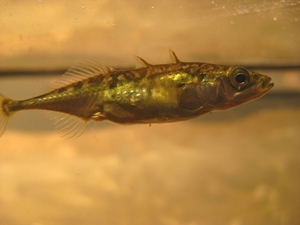The stickleback
 When I was a nipper, I had a number of aquariums on the go. Not with any frilly, brightly coloured warm water loving “foreign” species, mind you! – Oh no, I kept home-caught sticklebacks and stone loaches in my tanks!
When I was a nipper, I had a number of aquariums on the go. Not with any frilly, brightly coloured warm water loving “foreign” species, mind you! – Oh no, I kept home-caught sticklebacks and stone loaches in my tanks!
Sticklebacks in particular fascinated me, and I would urge anyone with children who show even the slightest interest in wildlife to set up a small tank with sticklebacks and encourage them to study these “tiddlers”. They are really easy to look after and – you never know – it might just be the trigger that starts a lifelong interest in natural history!
In the UK there are three recognised species: the three-spined stickleback Gasterosteus aculeatus and the nine-spined stickleback Pungitius pungitius can be found in freshwater, saltwater or brackish waters, whereas the fifteen-spined stickleback Spinachia spinachia is purely marine.
I am going to concentrate here on the most commonly found species in the UK: the three-spined stickleback. They are found widely in ponds, lakes, ditches, streams and rivers but don’t always have three spines along their back, sometimes there are only two and occasionally there are four. These sharp spines, coupled with large bony side plates (which they have rather than scales) help to provide some protective armour against predators.
Should another fish try to swallow a stickleback, the fish will immediately raise up the spines so that it cannot be swallowed, resulting in all but the largest fish having to spit the potential meal back out, completely unharmed!
Sticklebacks are noted for their highly ritualized breeding behaviour, with the male in particular playing a key role. Breeding usually takes place during the spring, by which time the male develops a bright red throat and belly and performs a striking “zig-zag” courtship dance to attract a mate. He also builds a roofed nest out of vegetation, all glued together by threadlike, mucous secretions from his kidneys, known as spiggin. (What a great word!)
The male then coaxes a female into the arched nest to lay her eggs, following her there so as to fertilize the eggs. More than one female may be chosen, and each female may lay up to 200 eggs. Once the nest is full, the male become an aggressive guard, attacking any intruder that dares to come close, while also fanning the eggs with his pectoral fins to supply them with oxygen, until they are ready to hatch some four weeks later.
All of these antics can be watched close up, taking place quite happily in your very own tank. You can feed your captive sticklebacks on tiny bits of chopped up worm or even raw mince.
So how do you go about catching your stickleback? Well that’s great fun too! I have put a link below for instructions on how to make your very own trap out of a plastic bottle. What is more I can vouch that these do work – and will catch you other things besides Sticklebacks!!
So come on parents – get those kids of yours away from the goggle-box and into some serious natural history studies! Keeping burnstickles, jacksharps, pricklebacks, baggie minnows or red doctors – some of the many vernacular names for the three-spined stickleback – should captivate the children. But even if it doesn’t, they will surely fascinate you!
Click here to download details of the stickleback trap.
Read more from Peter’s Blog - http://freshfromthefield.blogspot.co.uk/
Peter Thompson
Advisory
Read more from Peter Thompson at the Fresh from the Field blog.
Image © JaySo83, used under the terms of the Creative Commons licence.

Download Peter Thompson's essential 26-page book, featuring beautiful photography and detailed profiles of Britain's wildlife
Download FREE >